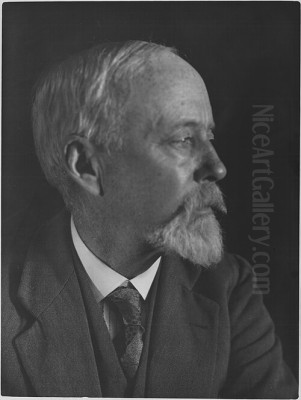
Maurice Galbraith Cullen stands as a seminal figure in the history of Canadian art. Born in St. John's, Newfoundland, on June 6, 1866, and passing away in Chambly, Quebec, on March 28, 1934, Cullen's life spanned a transformative period in Canadian culture. He is widely celebrated as one of the first and most significant artists to introduce and adapt Impressionism to the Canadian landscape, particularly mastering the depiction of Quebec's distinct seasons, most notably its luminous, snow-covered winters. His work bridged the gap between European modernism and a burgeoning Canadian artistic identity.
Early Life and Artistic Awakening
Cullen's journey into the world of art was not immediate. His family relocated from the maritime environment of Newfoundland to the bustling city of Montreal when he was just four years old. This move placed him in a burgeoning cultural centre that would eventually shape his artistic path. Initially, like many young men of his era, he ventured into the world of commerce, seeking a practical career.
However, the pull towards artistic expression proved stronger. Cullen soon abandoned his business pursuits to dedicate himself to art. His formal training began in Montreal under the tutelage of notable figures. He studied sculpture with Louis-Philippe Hébert, a prominent sculptor known for his public monuments, which provided Cullen with a foundational understanding of form and structure. Simultaneously, he learned painting from Abbé Joseph Chabert, a more traditional instructor, at the National Institute of Fine Arts and Sciences. These early studies laid the groundwork for his later explorations in paint.
Parisian Immersion: Embracing Impressionism
The pivotal moment in Cullen's artistic development came in 1888 or 1889 (sources vary slightly on the exact year) when, following a small inheritance, he travelled to Paris, the undisputed centre of the art world at the time. This journey immersed him in the currents of modern art that were revolutionizing painting. He enrolled in prestigious institutions like the École des Beaux-Arts, studying under history painter Jean-Léon Gérôme, and also attended classes at the Académie Julian and the Académie Colarossi, seeking diverse instruction.
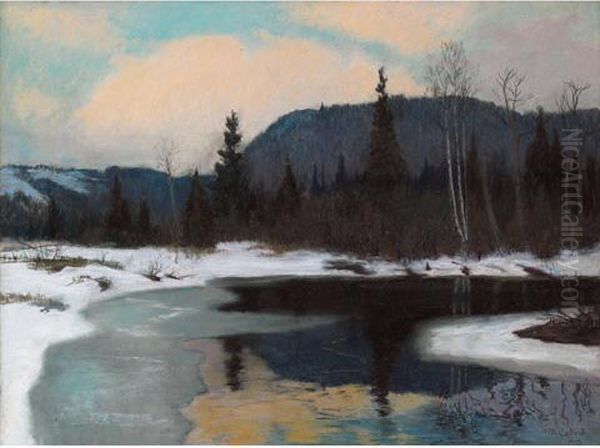
While academic training provided technical skills, it was the revolutionary style of Impressionism that truly captured Cullen's imagination. He absorbed the lessons of artists who prioritized capturing fleeting moments, the effects of light, and atmospheric conditions. The influence of Claude Monet is undeniable in Cullen's work, particularly in his treatment of light on snow and water. He also likely studied the works of Camille Pissarro and Alfred Sisley, other masters of the Impressionist landscape.
Cullen quickly gained recognition in Paris. He began exhibiting at the Salons, and in 1895, a significant honour was bestowed upon him when he was elected an Associate of the Société Nationale des Beaux-Arts (SNBA). This acknowledgment from the French art establishment was a testament to his talent and his successful assimilation of modern French painting techniques. His time in Paris was crucial, equipping him with a new visual language to interpret the world.
Return to Canada: Forging a National Style
Cullen returned to Montreal in 1895, bringing with him the techniques and sensibilities of French Impressionism. However, applying this style, developed under the softer light and different climate of France, to the starker, more dramatic Canadian landscape presented a unique challenge. The intense light, deep shadows, and vast, snow-covered expanses of the Canadian winter required adaptation.
He dedicated himself to this task, becoming one of the first Canadian artists to consistently paint en plein air (outdoors) even during the harsh winter months. He developed a palette capable of capturing the subtle blues, mauves, pinks, and yellows reflected in snow and ice, moving beyond the simple depiction of white. His brushwork became bolder, yet sensitive to the nuances of texture and atmosphere.
Initially, his modern, French-influenced style was met with some resistance from a Canadian art establishment still largely rooted in more conservative, academic traditions. Some critics found his work "too French." However, Cullen persevered, convinced that Impressionism offered the ideal means to capture the unique atmospheric effects and transient beauty of his homeland. He gradually won over audiences and critics alike.
Master of the Winter Landscape
While Cullen painted various subjects, including urban scenes and nocturnes, he is most renowned for his mastery of the Canadian winter landscape. He possessed an extraordinary ability to convey the crisp air, the biting cold, the muffled silence of snow-covered terrain, and the particular quality of light during Quebec's long winters.
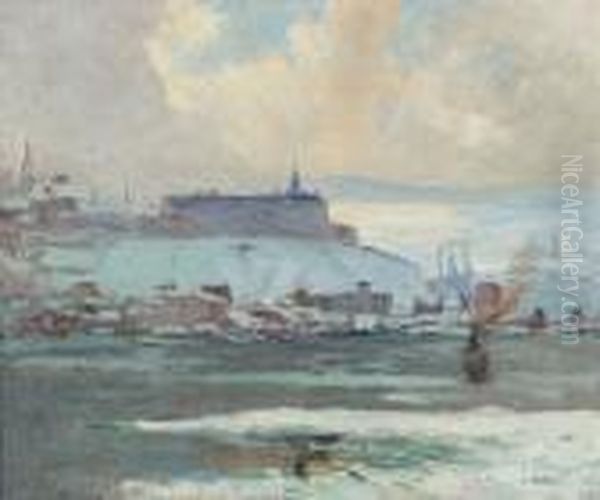
His snow scenes are not merely white expanses; they are vibrant studies in reflected light and subtle colour. He captured the low sun casting long blue shadows, the sparkle of frost, the deep turquoise hues of frozen rivers, and the warm glow of lights from villages nestled in the snow. Works like Logging in Winter, Beaupré (c. 1896) exemplify his early success in depicting human activity within the winter landscape, rendered with Impressionistic vitality.
Other iconic winter paintings include Ice Harvest (c. 1913), showcasing the labour involved in cutting blocks of ice from the St. Lawrence River, a common sight before refrigeration. The Cache River paintings explore the remote wilderness, often under moonlight or twilight, evoking a sense of profound stillness and mystery. Winter Evening, Quebec (c. 1905) captures the charm of the old city under a blanket of snow, with glowing windows suggesting warmth within. His dedication to this subject matter established winter as a viable and expressive theme for Canadian painters.
Urban Views and Nocturnes
Beyond the rural winter, Cullen was also a sensitive observer of urban life, particularly in Montreal and Quebec City. He often chose to paint at twilight or night, fascinated by the interplay of natural and artificial light. Gas lamps, electric lights, and reflections on wet streets or snowy surfaces provided rich subjects for his Impressionist techniques.
These nocturnes possess a distinct mood, often blending the romanticism of the city at night with a modern sensibility. Paintings like Old Houses, Montreal or Quebec from Lévis demonstrate his ability to capture the architectural character and atmospheric conditions of the urban environment. He treated the city not just as a collection of buildings, but as a living entity with its own unique light and shadow patterns, particularly under the transformative veil of evening or snowfall.
Relationships with Contemporaries
Cullen was an active participant in the Montreal art scene. He was a member of the Pen and Pencil Club, a social and artistic group where he interacted with fellow artists like the portraitist Robert Harris and landscape painter William Hope. He maintained a significant and complex friendship with James Wilson Morrice, another leading Canadian modernist who spent much of his time abroad.
Cullen and Morrice occasionally shared studios and undertook sketching trips together, including visits to Grèz-sur-Loing in France and locations around Quebec. While friends, their styles differed; Morrice's work often featured more simplified forms and a focus on tonal harmonies, influenced perhaps more by Post-Impressionism and Whistler, whereas Cullen remained closer to a classic Impressionist rendering of light and atmosphere. Their mutual respect, however, was evident.

William Brymner, an influential teacher at the Art Association of Montreal (AAM) and a respected painter in his own right, was another important figure in Cullen's circle. Brymner, though perhaps more conservative in his own work initially, recognized Cullen's talent and supported the introduction of modern ideas. Cullen would later teach alongside Brymner at the AAM. He also associated with Edmund Morris, another key figure in early Canadian modernism and a driving force behind the Canadian Art Club.
Teaching and Profound Influence
Maurice Cullen's impact extends significantly beyond his own canvases through his role as an educator. He began teaching drawing and painting classes at the Art Association of Montreal (AAM), the precursor to the Montreal Museum of Fine Arts, around 1910, taking over classes previously taught by William Brymner. His teaching was informed by his Parisian training and his direct experience adapting Impressionism to Canadian conditions.
He became a mentor figure for a generation of younger artists, encouraging them to look directly at their environment and to experiment with modern techniques. His influence was particularly crucial for several artists who would later form the core of the Group of Seven, Canada's most famous school of landscape painters. A. Y. Jackson explicitly acknowledged Cullen (along with J. W. Morrice) as paving the way, demonstrating that the Canadian landscape, even its rugged aspects, could be painted in a vital, contemporary manner.
Lawren Harris and J. E. H. MacDonald also absorbed lessons from Cullen's approach to light and colour, even as they developed their own distinct, more stylized approaches to the landscape. Other notable students and artists influenced by Cullen include his stepson Robert Pilot, who became a respected painter in his own right, Edwin Holgate (also later a Group of Seven member), and the portraitist Lilias Torrance Newton. Cullen's teaching helped foster a climate of modernism in Montreal and beyond.
The War Years: An Official Artist
During the First World War, Cullen's artistic skills were employed in service of the nation. He was commissioned as an official war artist by the Canadian War Memorials Fund, established by Lord Beaverbrook. Along with other prominent artists like Frederick Varley and A. Y. Jackson, Cullen travelled to the Western Front in 1918.
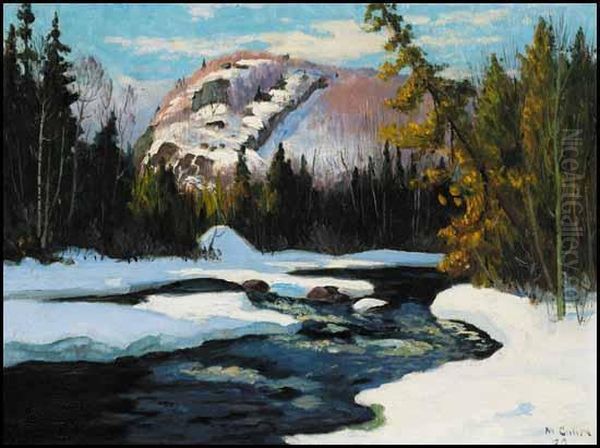
His war paintings differ somewhat from the dramatic battle scenes produced by some of his colleagues. Cullen often focused on the scarred landscapes of France and Flanders, depicting the effects of shelling, ruined villages, and the atmospheric conditions of the front lines. Works like Bombardment or scenes of devastated towns showcase his continued interest in light and atmosphere, now applied to the grim realities of war. These works form an important part of Canada's visual record of the conflict, rendered with his characteristic sensitivity to place and mood.
Recognition and Professional Affiliations
Throughout his career, Cullen gained significant recognition within the Canadian art establishment, despite the initial skepticism towards his modern style. He was elected an Associate of the Royal Canadian Academy of Arts (RCA) in 1899 and became a full Academician in 1907, signifying his acceptance by the country's premier art institution.
He was also a founding member of the Canadian Art Club in 1907. This Toronto-based exhibiting society aimed to raise the standard of Canadian art and provide a venue for more progressive artists, including Cullen, Morrice, Edmund Morris, and Homer Watson. His involvement with the Art Association of Montreal was long-standing, both as an exhibitor and later as an influential teacher. His earlier election as an Associate of the Société Nationale des Beaux-Arts in Paris remained a prestigious credential throughout his life. He exhibited regularly in Canada and occasionally internationally, solidifying his reputation.
Artistic Legacy and Critical Evaluation
Maurice Cullen's legacy is firmly established as a foundational figure in Canadian modern art. He played a crucial role in introducing Impressionism to Canada, not merely copying a French style, but thoughtfully adapting its principles to capture the unique light, atmosphere, and character of the Canadian landscape, particularly Quebec. His pioneering depictions of winter demonstrated that this challenging season could be a subject of profound beauty and artistic expression.
While some early critics debated whether his work was authentically "Canadian" or overly influenced by France, subsequent generations came to view his paintings as quintessential representations of the Quebec landscape. Art historians now recognize his vital role in bridging 19th-century traditions and 20th-century modernism in Canada. His emphasis on direct observation, plein air painting, and capturing the effects of light profoundly influenced the artists who followed, most notably the Group of Seven, who built upon the foundation he helped lay.
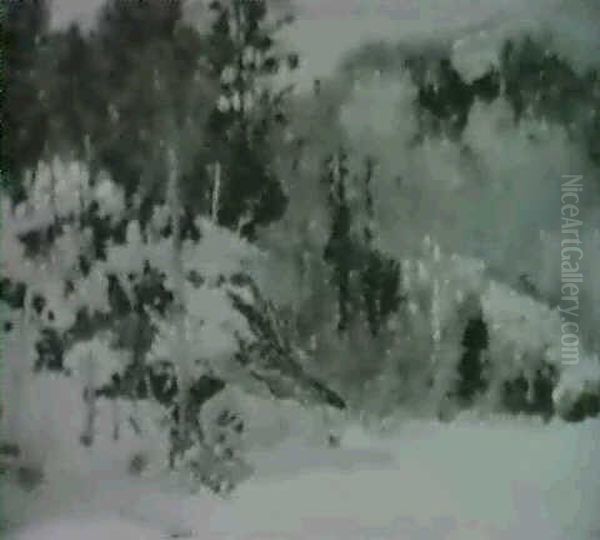
His works are held in major public collections across Canada, including the National Gallery of Canada in Ottawa, the Montreal Museum of Fine Arts, the Art Gallery of Ontario in Toronto, and numerous other institutions. Retrospectives of his work continue to affirm his importance and enduring appeal. He demonstrated that Canadian artists could engage with international modernism while remaining true to their own environment.
Later Life and Enduring Significance
In his later years, Cullen continued to paint actively, often returning to the familiar landscapes around Montreal and the Laurentians. He eventually settled in Chambly, south of Montreal, where he passed away in 1934 at the age of 67. While specific anecdotes about his private life are scarce in historical records, his dedication to his art remained constant throughout his life.
Maurice Galbraith Cullen's contribution to Canadian art is immense. He was more than just a painter of snow; he was an innovator who fundamentally changed how Canadian artists perceived and depicted their own country. By embracing Impressionism and adapting it with sensitivity and skill, he opened up new possibilities for landscape painting in Canada, leaving behind a rich body of work that continues to resonate with its evocative portrayal of light, atmosphere, and place. He remains a cornerstone figure, essential for understanding the development of modern art in Canada.